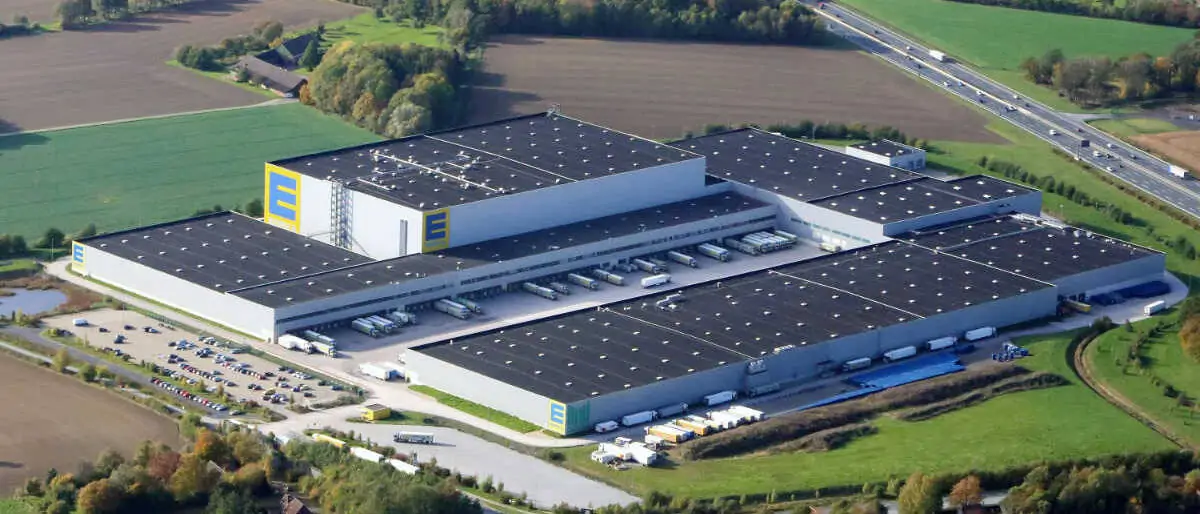In distribution logistics, the decision on where to locate warehouses is a strategic one. A general distinction is made between centralized and decentralized locations, which affect logistics costs (see also inventory costs) and delivery service (see also Perfect Order Fulfillment) can affect the costs; however, a combination of both variants is also possible.
A centralized warehouse combines the entire product range (see also product range dimensions) of one or more manufacturers. Usually, customers are supplied from a single location, while decentralized solutions have several strategically and geographically distributed warehouses that generally do not hold the entire product range in stock.
Characteristics of a central warehouse
Since, as already mentioned, ‘all’ orders and thus all shipments are processed exclusively from a central location, there is a high turnover rate within a central distribution center; this often requires an equally high degree of automation. The high degree of automation of a central distribution center is also favored because it is easier to implement item-specific storage and standardization; the administrative effort is also lower. However, not all customer requests/orders can be fulfilled equally quickly, since, for example, the distances to the customer vary greatly at a single location.
Advantages of a central warehouse
- Lower storage costs / lower location costs
- More efficient warehouse organization and management
- High degree of automation possible
- Low personnel costs
- If the location is central, relatively short transport distances
- High readiness to deliver (high availability of inventory)
- Lower minimum stock level
- Generally optimal warehouse equipment
- Bundling of efficient tools (high-bay warehouse, AGV, , bag sorter)
- Centralization of warehouse processes (high degree of standardization)
Disadvantages of a central warehouse
- Less delivery flexibility
- High transport costs (if the location is not optimally chosen)
- Longer transport routes
- Delivery to the location usually once a day
Characteristics of a decentralized warehouse
Optimal distribution can also mean operating several decentralized warehouses. These do not necessarily have to be operated by the company itself; as with the central distribution center, logistics service providers can also be hired for this purpose. The purpose of decentralized warehouses is to ensure that the right inventory is located relatively close to the customer, which allows for more delivery flexibility and shorter delivery times. For example, if a company’s market is located abroad, then it makes sense to locate a decentralized warehouse at the airport.
Communication and coordination between the company headquarters and the warehouses and between the warehouses themselves is particularly important for decentralized warehouses. It is essential to always know exactly how much and which inventory or material is in which warehouse in order to plan optimal transport routes and save costs; professional recording and communication of inventory levels and stock movements are therefore indispensable (see also < a href=“https://www.tup.com/lkh/bestandsverwaltung/die-bestandsverwaltung-in-der-intralogistik/”>inventory management).
Advantages of a decentralized warehouse
- High delivery flexibility
- Lower transport costs
- Shorter delivery time (dispatch)
- Supply to the location usually up to three times a day
Disadvantages of decentralized warehousing
- Risk of misallocation (inventory not located at the most favorable local storage site)
- Higher investment and operating costs
- Higher control effort (warehouse management, CEP service providers and packaging materials.
Retailers are trying to meet this challenge by identifying stationary shops as decentralized storage locations and using these stocks to exploit their close proximity to customers even more efficiently (keyword: same day delivery). So you will find more and more offers such as Click and Collect (Cross-Channel) or specialized software solutions for retailer integration.
Summary: centralized and decentralized warehousing
There are generally two different types of warehousing: centralized and decentralized warehousing. As a rule, storage costs are low at a central distribution center, while transport costs are high; in the case of decentralized warehousing, however, the situation is exactly the opposite. A combination of both types of warehousing is also possible; in this case, a central warehouse not only supplies customers but also other warehouses that function as branch, regional or transshipment warehouses. Neither type of warehousing necessarily has to be operated by the company itself; it can also be outsourced to a logistics service provider. The decision for a particular type of warehouse is very individual and cannot be answered in general terms; ultimately, the customer and their satisfaction is an extremely important factor.
Teaser image: Tim Reckmann / CC BY-SA 3.0
